Abstract
1. The question of whether there is any interaction between the peripheral and central chemoreceptor contributions to ventilation in man has been addressed. 2. Subjects were exposed to an end-tidal PCO2 of ca. 10 Torr above resting for 8 min at an end-tidal PO2 of 100 Torr. The end-tidal PCO2 was then reduced to near eucapnia. This provided a period of time when the PCO2 at the peripheral chemoreceptors would be near eucapnia, but would still be raised at the central chemoreceptors. 3. Against the background above, the effect of an hypoxic end-tidal step from a PO2 of 100 Torr to a PO2 of 50 Torr was studied, and compared with the effect of the same step when both sets of chemoreceptors were near eucapnia. 4. Three subjects were studied, each contributing twelve sets of data to each of the three protocols required for the comparisons. 5. In two of the three subjects, the ventilatory response to hypoxia was augmented when central PCO2 was high. 6. The results support the idea that there is an interaction between the central and peripheral chemoreceptors in man. The consequences of this and other possible interpretations of the results are discussed.
Full text
PDF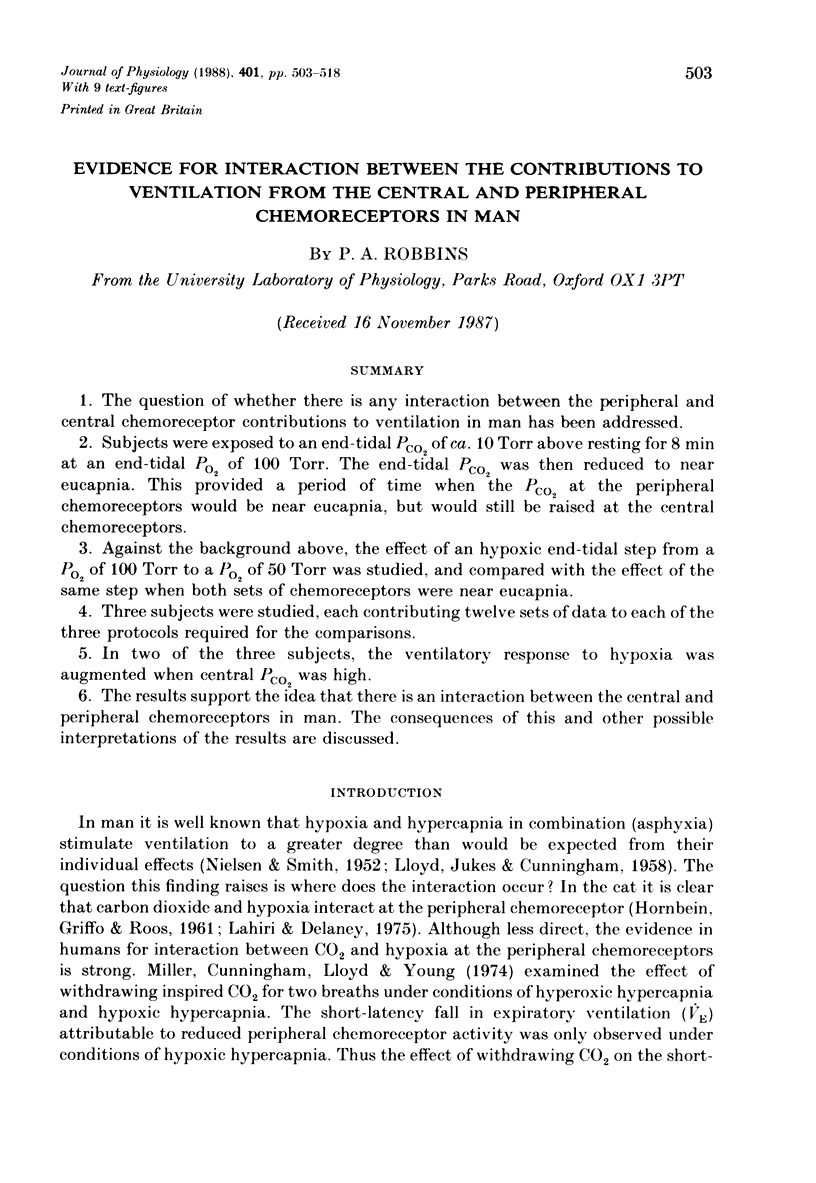
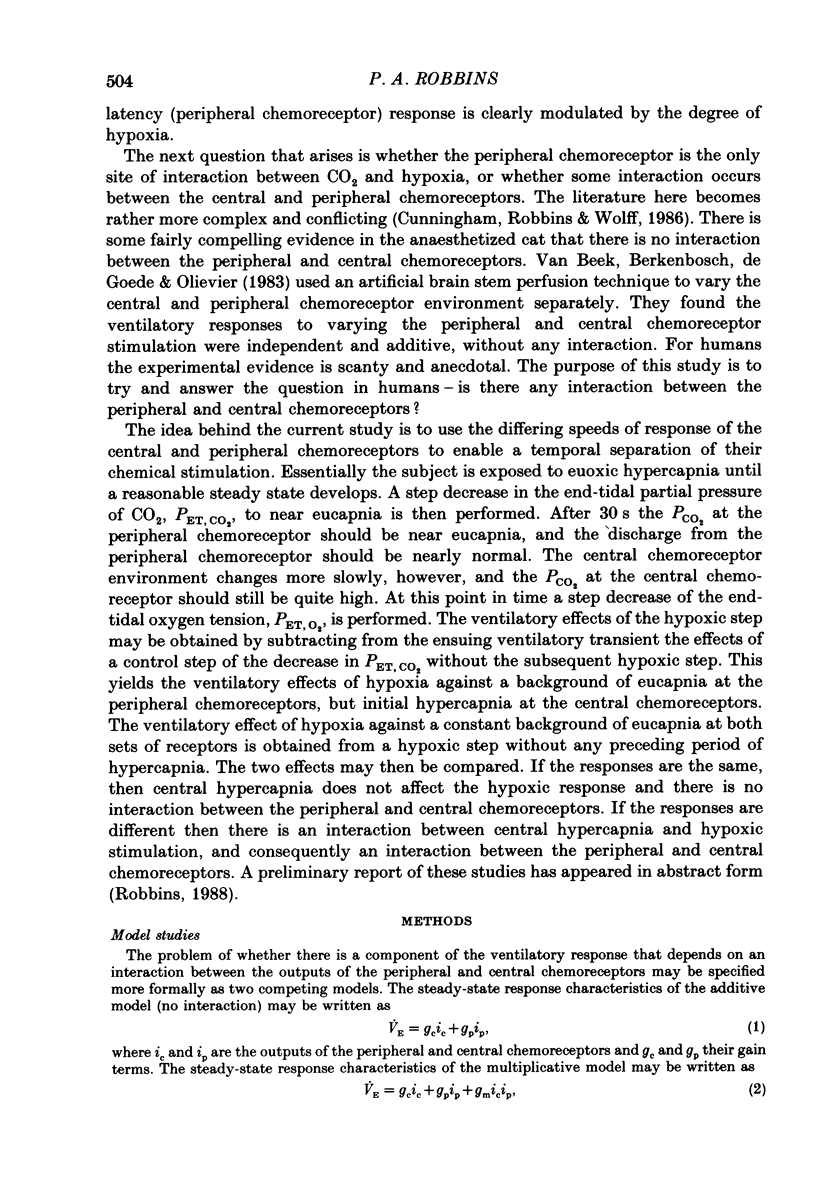




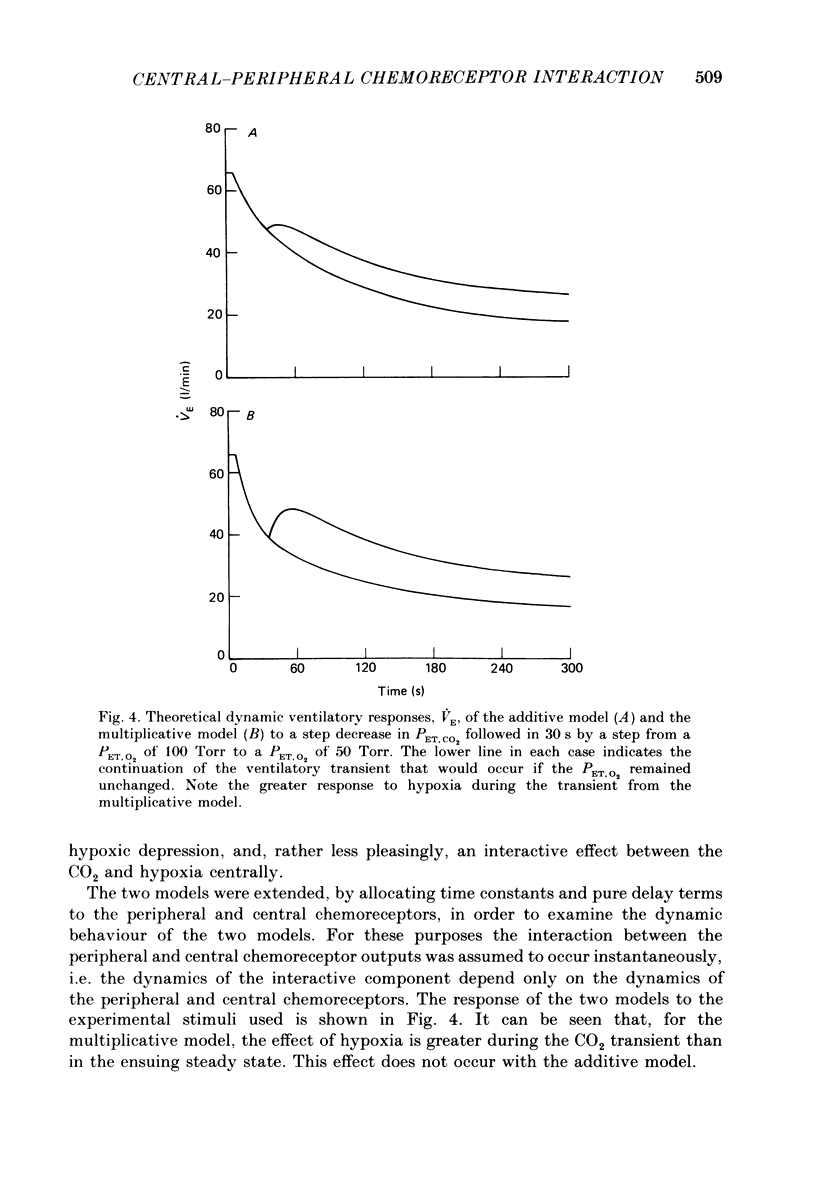

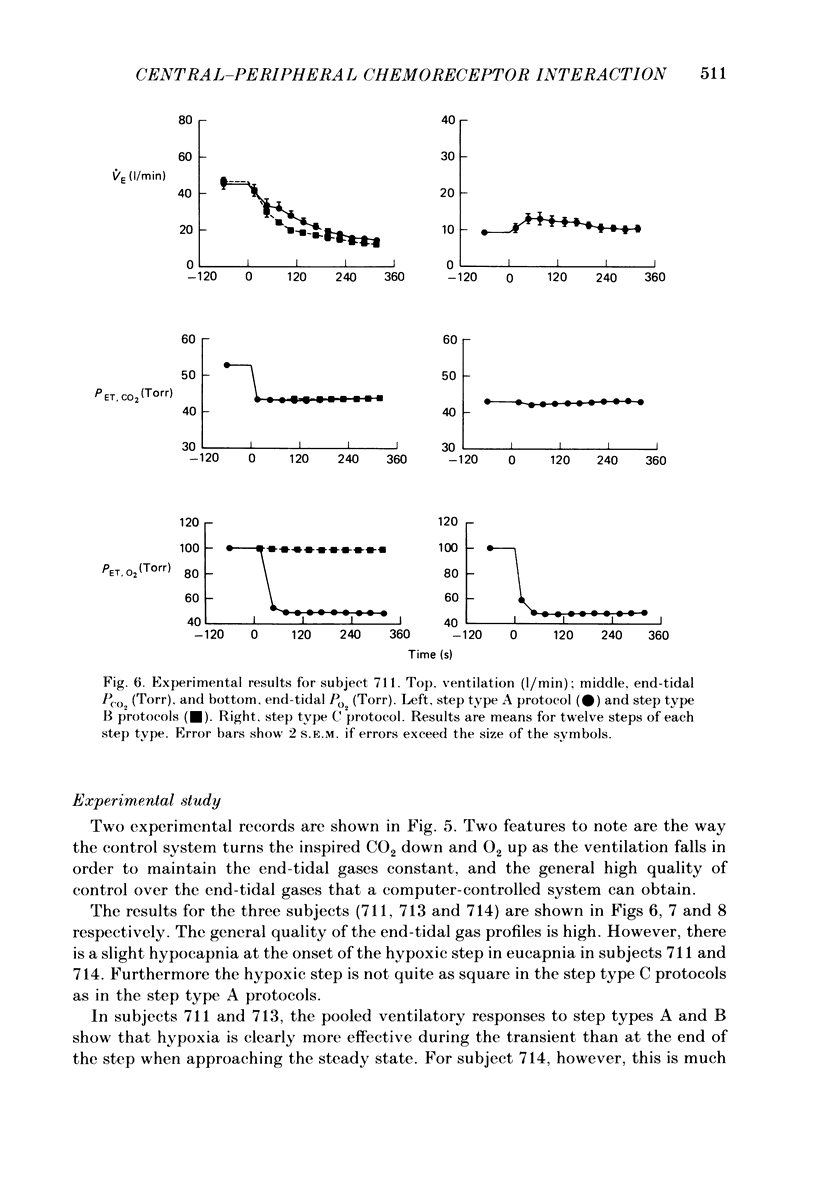

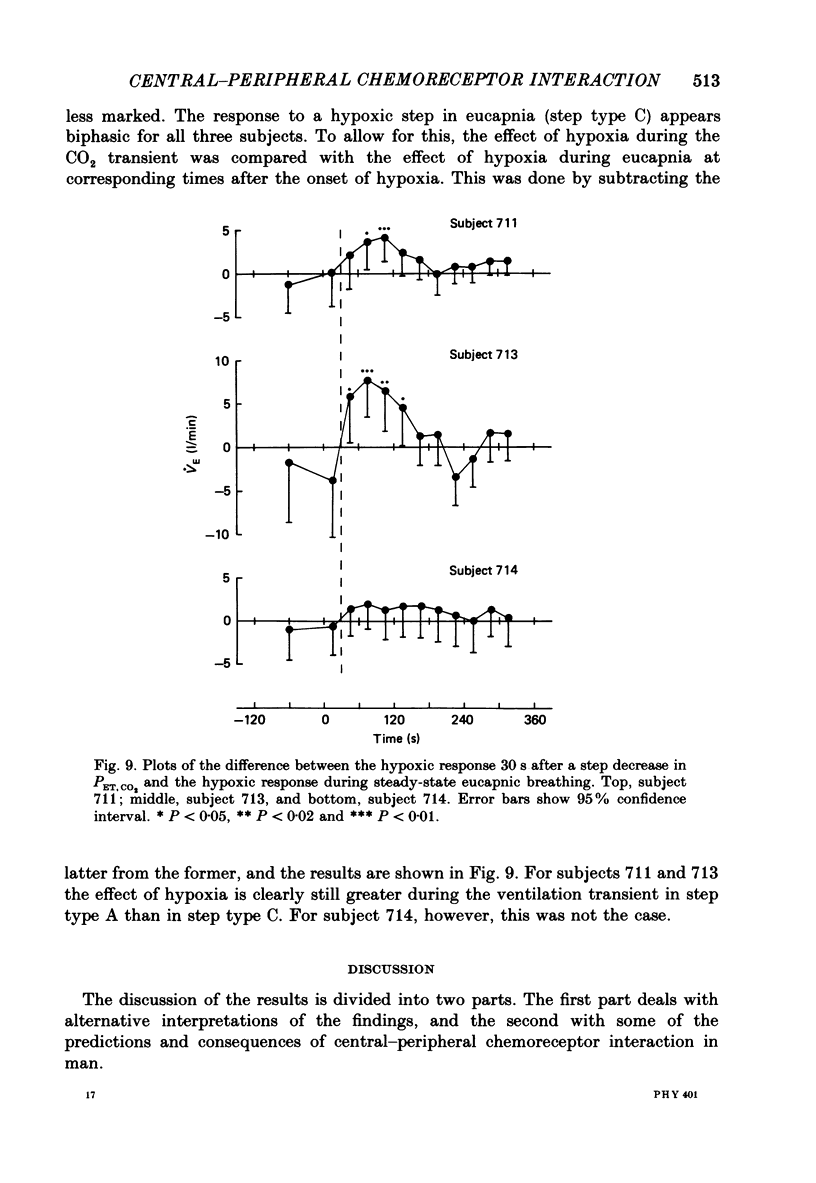

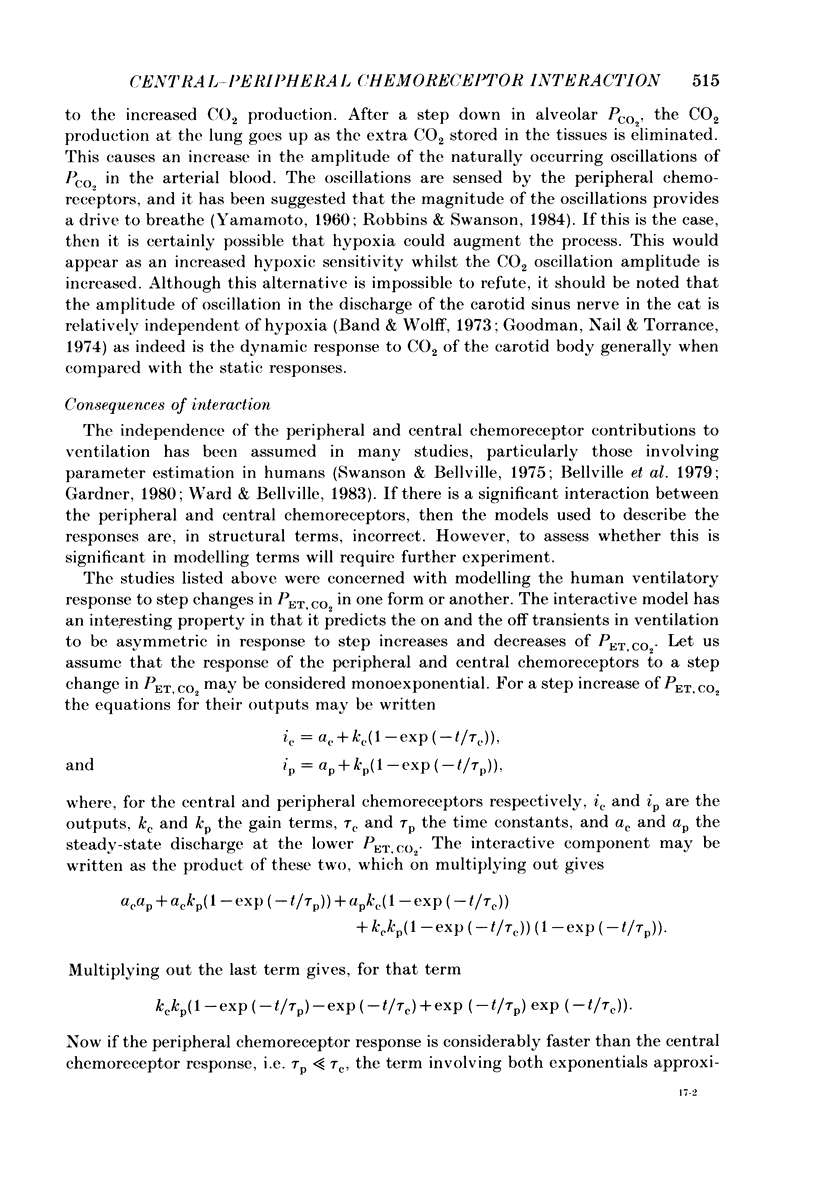



Selected References
These references are in PubMed. This may not be the complete list of references from this article.
- Band D. M., Wolff C. B. Proceedings: The effect of hypoxia on the respiratory fluctuations in chemoreceptor discharge in the cat. J Physiol. 1973 Oct;234(2):71P–72P. [PubMed] [Google Scholar]
- Bellville J. W., Whipp B. J., Kaufman R. D., Swanson G. D., Aqleh K. A., Wiberg D. M. Central and peripheral chemoreflex loop gain in normal and carotid body-resected subjects. J Appl Physiol Respir Environ Exerc Physiol. 1979 Apr;46(4):843–853. doi: 10.1152/jappl.1979.46.4.843. [DOI] [PubMed] [Google Scholar]
- Black A. M., McCloskey D. I., Torrance R. W. The responses of carotid body chemoreceptors in the cat to sudden changes of hypercapnic and hypoxic stimuli. Respir Physiol. 1971 Oct;13(1):36–49. doi: 10.1016/0034-5687(71)90063-6. [DOI] [PubMed] [Google Scholar]
- Easton P. A., Slykerman L. J., Anthonisen N. R. Ventilatory response to sustained hypoxia in normal adults. J Appl Physiol (1985) 1986 Sep;61(3):906–911. doi: 10.1152/jappl.1986.61.3.906. [DOI] [PubMed] [Google Scholar]
- Gardner W. N. The pattern of breathing following step changes of alveolar partial pressures of carbon dioxide and oxygen in man. J Physiol. 1980 Mar;300:55–73. doi: 10.1113/jphysiol.1980.sp013151. [DOI] [PMC free article] [PubMed] [Google Scholar]
- Goodman N. W., Nail B. S., Torrance R. W. Oscillations in the discharge of single carotid chemorecptor fibers of the cat. Respir Physiol. 1974 Jun;20(3):251–269. doi: 10.1016/0034-5687(74)90023-1. [DOI] [PubMed] [Google Scholar]
- HORNBEIN T. F., GRIFFO Z. J., ROOS A. Quantitation of chemoreceptor activity: interrelation of hypoxia and hypercapnia. J Neurophysiol. 1961 Nov;24:561–568. doi: 10.1152/jn.1961.24.6.561. [DOI] [PubMed] [Google Scholar]
- LLOYD B. B., JUKES M. G., CUNNINGHAM D. J. The relation between alveolar oxygen pressure and the respiratory response to carbon dioxide in man. Q J Exp Physiol Cogn Med Sci. 1958 Apr;43(2):214–227. doi: 10.1113/expphysiol.1958.sp001319. [DOI] [PubMed] [Google Scholar]
- Lahiri S., DeLaney R. G. Stimulus interaction in the responses of carotid body chemoreceptor single afferent fibers. Respir Physiol. 1975 Sep;24(3):249–266. doi: 10.1016/0034-5687(75)90017-1. [DOI] [PubMed] [Google Scholar]
- Michel C. C., Lloyd B. B., Cunningham D. J. The in vivo carbon dioxide dissociation curve of true plasma. Respir Physiol. 1966;1(2):121–137. doi: 10.1016/0034-5687(66)90011-9. [DOI] [PubMed] [Google Scholar]
- Miller J. P., Cunningham D. J., Lloyd B. B., Young J. M. The transient respiratory effects in man of sudden changes in alveolar CO2 in hypoxia and in high oxygen. Respir Physiol. 1974 Feb;20(1):17–31. doi: 10.1016/0034-5687(74)90015-2. [DOI] [PubMed] [Google Scholar]
- NIELSEN M., SMITH H. Studies on the regulation of respiration in acute hypoxia; with a appendix on respiratory control during prolonged hypoxia. Acta Physiol Scand. 1952 Feb 12;24(4):293–313. doi: 10.1111/j.1748-1716.1952.tb00847.x. [DOI] [PubMed] [Google Scholar]
- Robbins P. A., Swanson G. D. Errors in seminal papers on within-breath time course of alveolar PCO2. J Appl Physiol Respir Environ Exerc Physiol. 1984 Jul;57(1):284–284. doi: 10.1152/jappl.1984.57.1.284. [DOI] [PubMed] [Google Scholar]
- Robbins P. A., Swanson G. D., Howson M. G. A prediction-correction scheme for forcing alveolar gases along certain time courses. J Appl Physiol Respir Environ Exerc Physiol. 1982 May;52(5):1353–1357. doi: 10.1152/jappl.1982.52.5.1353. [DOI] [PubMed] [Google Scholar]
- Robbins P. A. The ventilatory response of the human respiratory system to sine waves of alveolar carbon dioxide and hypoxia. J Physiol. 1984 May;350:461–474. doi: 10.1113/jphysiol.1984.sp015212. [DOI] [PMC free article] [PubMed] [Google Scholar]
- Swanson G. D., Bellville J. W. Step changes in end-tidal CO2: methods and implications. J Appl Physiol. 1975 Sep;39(3):377–385. doi: 10.1152/jappl.1975.39.3.377. [DOI] [PubMed] [Google Scholar]
- Ward D. S., Bellville J. W. Effect of intravenous dopamine on hypercapnic ventilatory response in humans. J Appl Physiol Respir Environ Exerc Physiol. 1983 Nov;55(5):1418–1425. doi: 10.1152/jappl.1983.55.5.1418. [DOI] [PubMed] [Google Scholar]
- YAMAMOTO W. S. Mathematical analysis of the time course of alveolar carbon dioxide. J Appl Physiol. 1960 Mar;15:215–219. doi: 10.1152/jappl.1960.15.2.215. [DOI] [PubMed] [Google Scholar]
- van Beek J. H., Berkenbosch A., de Goede J., Olievier C. N. Effects of brain stem hypoxaemia on the regulation of breathing. Respir Physiol. 1984 Aug;57(2):171–188. doi: 10.1016/0034-5687(84)90091-4. [DOI] [PubMed] [Google Scholar]
- van Beek J. H., Berkenbosch A., de Goede J., Olievier C. N. Influence of peripheral O2 tension on the ventilatory response to CO2 in cats. Respir Physiol. 1983 Mar;51(3):379–390. doi: 10.1016/0034-5687(83)90030-0. [DOI] [PubMed] [Google Scholar]


